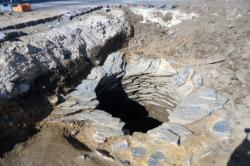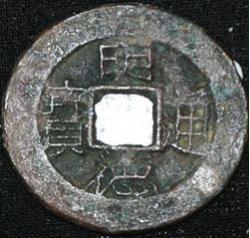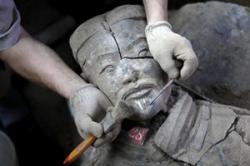04 OCTOBRE
INDI-UNI : ANTHROPOLOGIE - ARCHEOLOGIE
INSCRIPTION 2011 – 2012 COURS A DISTANCE
REGISTRATION 2011 – 2012 ONLINE COURSES
FRANCE –  Angers - Sur la place Lorraine, les archéologues ont mis en évidence un ensemble de fosses dépotoirs a avec beaucoup de mobilier céramique dont la datation s'échelonne de la première moitié du premier siècle (Auguste et Tibère) jusqu'au tout début du IIIe siècle. Ils ont également noté de nombreux pesons de tisserands, de scories de fer, et de vases de stockage (dolia et amphores), dont certains sont presque complets ainsi que quelques pièces de monnaie romaines. Une structure de forme rectangulaire a attiré plus particulièrement l’attention des chercheurs. Cette structure qui mesure 3,90 m par 4,10 m n'est pas sans rappeler celles de la place Leclerc, découvertes en 1987 lesquelles correspondaient à des mausolées en bordure de la voie conduisant au Mans. Ce petit édifice a livré une monnaie de la période augustéenne (sous réserve) mais très usée. « Ce qui est certain, c'est que lors de la destruction de la structure, sans doute à la fin du second siècle, on a cherché à récupérer le contenu, puisque l'angle bétonné avait été arraché pour revisiter cette fosse dont on connaissait donc l'existence », ont précisé les chercheurs de l’INRAP. Les recherches sur la voie antique voisine sont restées vaines.
Angers - Sur la place Lorraine, les archéologues ont mis en évidence un ensemble de fosses dépotoirs a avec beaucoup de mobilier céramique dont la datation s'échelonne de la première moitié du premier siècle (Auguste et Tibère) jusqu'au tout début du IIIe siècle. Ils ont également noté de nombreux pesons de tisserands, de scories de fer, et de vases de stockage (dolia et amphores), dont certains sont presque complets ainsi que quelques pièces de monnaie romaines. Une structure de forme rectangulaire a attiré plus particulièrement l’attention des chercheurs. Cette structure qui mesure 3,90 m par 4,10 m n'est pas sans rappeler celles de la place Leclerc, découvertes en 1987 lesquelles correspondaient à des mausolées en bordure de la voie conduisant au Mans. Ce petit édifice a livré une monnaie de la période augustéenne (sous réserve) mais très usée. « Ce qui est certain, c'est que lors de la destruction de la structure, sans doute à la fin du second siècle, on a cherché à récupérer le contenu, puisque l'angle bétonné avait été arraché pour revisiter cette fosse dont on connaissait donc l'existence », ont précisé les chercheurs de l’INRAP. Les recherches sur la voie antique voisine sont restées vaines.
http://www.angersmag.info/Place-Lorraine-les-fouilles-archeologiques-sont-terminees_a3448.html
VIET NAM –  An Giang - The Viet Nam Institute of Archaeology has announced new discoveries unearthed during the recent excavation of Thoai Ngoc Hau and his wives' tombs, including a coin dating back to the Tay Son dynasty (1778-1802). Thoai Ngoc Hau (1761-1829), a famous general, helped Nguyen Anh found the Nguyen dynasty (1802-1945). He and his wives were buried in the southern province of An Giang. The excavation of their tombs was carried out on September 19 by local experts. They discovered a number of artefacts buried near the tombs of Chau Thi Te and Truong Thi Met, his first and second wives. The name on the coin was Minh Duc Thong Bao, minted under the reign of Nguyen Nhac (1788-1793). The discovery in the tomb of the high ranking mandarin's wife has been seen as a possible breakthrough by archaeologists. According to Pham Huu Cong, it could relate to a secret that had never been made public. "Perhaps the couple had a relationship with the Tay Son movement, the Nguyen kings' foes, and kept the coin as a momento, despite the trouble it could cause. When Chau Thi Te died in 1826, the mandarin buried this coin with her," he said. Cong also noted that many of the objects they had found had been buried outside of the tombs. This could be another way of burying the dead, he added. "Archaeologists should bear this in mind during future excavations, especially Nguyen dynasty graves. We should also look at previous sites to see if there is anything we missed," Cong said.Archaeologists unearthed 523 objects ranging from pottery to bronzeware, but perhaps the most spectacular find was a hat adorned with 33 gems that probably belonged to a high ranking mandarin.
An Giang - The Viet Nam Institute of Archaeology has announced new discoveries unearthed during the recent excavation of Thoai Ngoc Hau and his wives' tombs, including a coin dating back to the Tay Son dynasty (1778-1802). Thoai Ngoc Hau (1761-1829), a famous general, helped Nguyen Anh found the Nguyen dynasty (1802-1945). He and his wives were buried in the southern province of An Giang. The excavation of their tombs was carried out on September 19 by local experts. They discovered a number of artefacts buried near the tombs of Chau Thi Te and Truong Thi Met, his first and second wives. The name on the coin was Minh Duc Thong Bao, minted under the reign of Nguyen Nhac (1788-1793). The discovery in the tomb of the high ranking mandarin's wife has been seen as a possible breakthrough by archaeologists. According to Pham Huu Cong, it could relate to a secret that had never been made public. "Perhaps the couple had a relationship with the Tay Son movement, the Nguyen kings' foes, and kept the coin as a momento, despite the trouble it could cause. When Chau Thi Te died in 1826, the mandarin buried this coin with her," he said. Cong also noted that many of the objects they had found had been buried outside of the tombs. This could be another way of burying the dead, he added. "Archaeologists should bear this in mind during future excavations, especially Nguyen dynasty graves. We should also look at previous sites to see if there is anything we missed," Cong said.Archaeologists unearthed 523 objects ranging from pottery to bronzeware, but perhaps the most spectacular find was a hat adorned with 33 gems that probably belonged to a high ranking mandarin.
http://vietnamnews.vnagency.com.vn/Life-Style/216072/Tay-Son-dynasty-coin-unearthed-.html
CHINE –  Mausoleum of Qin Shihuang - Two new pits of civil servant and acrobat terracotta figures at the mausoleum of Emperor Qin Shihuang (259 BC-210 BC) have opened to the public this month. The acrobat pit, coded K9901 and discovered in 1999, lies in the southeast of the mausoleum of Qin Shihuang. The 11 unearthed terracotta figures, unarmoured with their torsos unclad, differ a lot from terracotta warriors. They might represent wrestlers, acrobats or dancers in the court of the Qin Dynasty, according to archaeologists. A bronze tripod was also found. It is the largest and heaviest in the mausoleum of Qin Shihuang.
Mausoleum of Qin Shihuang - Two new pits of civil servant and acrobat terracotta figures at the mausoleum of Emperor Qin Shihuang (259 BC-210 BC) have opened to the public this month. The acrobat pit, coded K9901 and discovered in 1999, lies in the southeast of the mausoleum of Qin Shihuang. The 11 unearthed terracotta figures, unarmoured with their torsos unclad, differ a lot from terracotta warriors. They might represent wrestlers, acrobats or dancers in the court of the Qin Dynasty, according to archaeologists. A bronze tripod was also found. It is the largest and heaviest in the mausoleum of Qin Shihuang.
http://www.3news.co.nz/New-pits-of-Chinese-terracotta-figures-opened/tabid/1160/articleID/228079/Default.aspx#ixzz1ZurXU5zd
SRI LANKA – Jaffna - Some stone weapons belonging to the Palaeolithic period have been unearthed in the Jaffna peninsula. This has also been assessed by Dr Shiran Deraniyagale, an expert on the pre-historic period, Deputy Archaeological Director Dr Nimal Perera told the Daily News. "Evidence has been found pertaining to the Palaeolithic period in locations in South India, South Asia and Africa. However, this is the first time in Sri Lanka's history that such objects have been found relating to the Palaeolithic period in the country," he said. "These findings were made in Manikkai, close to Point Pedro in 1984. Nevertheless due to the 30 year war, excavation came to a halt making it impossible to unearth any evidence. "Under the excavation project of Kantharodei, a combined project was launched by the Archaeological Department and the Jaffna University. Prof Krishna Raja of the Jaffna University found the stone weapons from the Jaffna peninsula," the deputy director said. Dr Perera said he inspected these weapons which were brought to Colombo and shown to Dr Deraniyagala who confirmed that the stone weapons belonged to the Palaeolithic period. He said there are four ancient and important historic towns in Sri Lanka. "They are Anuradhapura, Tissamaharama, Mathota and Jaffna. No pre- historic evidence was found in Jaffna upto now. The department has begun excavations in the area now," he said.
http://www.dailynews.lk/2011/10/03/news11.asp
ROYAUME UNI - Willow Tree Fen - Archaeologists have been unearthing the story of a 2,000-year-old salt making site on the Lincolnshire fens.Artefacts such as pottery, hair pins and tools have been found by volunteers at Willow Tree Fen, near Bourne. Experts were invited to excavate the site by Lincolnshire Wildlife Trust prior to the area becoming a nature reserve.
VIDEO - http://www.bbc.co.uk/news/uk-england-lincolnshire-15168543
ROYAUME UNI – Inverness - When it came to finding the perfect place to live, it seemed Bronze Age man and woman could have done worse than to settle in the Inverness area. Slackbuie — close to where the Asda supermarket is being built — was particularly desirable for inhabitants up to 4000 years ago. There is already well-documented evidence from previous archaeological excavations indicating early human activity at both Slackbuie and nearby Culduthel which was a bustling pre-historic industrial estate of epic proportions. Archaeologists last year uncovered a Bronze Age burial site, featuring cremation pits surrounded by a ring ditch, while hundreds of flint flakes were discovered in a nearby field.Pieces of Neolithic pottery known as Unstan Ware were also discovered during the digs. Excavations led by the AOC Archaeology Group on the site of the proposed new Inverness Campus on the city’s eastern outskirts have revealed evidence of Bronze and Iron Age settlements, for example. Archaeologists working at the Beechwood site, which is being developed by Highlands and Islands Enterprise, recorded the remains of timber-built roundhouses and crop marks and also uncovered fragments of prehistoric pottery, including Neolithic grooved ware.
http://www.inverness-courier.co.uk/Features/Digging-into-Inverness-past-04102011.htm
USA – Philadelphia - With all the development that has occurred in Philadelphia, archaeologists thought it unlikely they would ever find significant remnants of early Native American cultures.Those artifacts would have been deeply buried, carted away, or crushed. But not long ago, along I-95 in North Philadelphia, they uncovered tobacco pipes, arrowheads, pottery, and other Native American artifacts dating back 3,000 years. Near Mount Holly, they have begun to unearth portions of the African American community of Timbuctoo, founded in the 1820s and a station on the Underground Railroad.
http://articles.philly.com/2011-10-02/news/30235346_1_archaeologists-artifacts-national-constitution-center